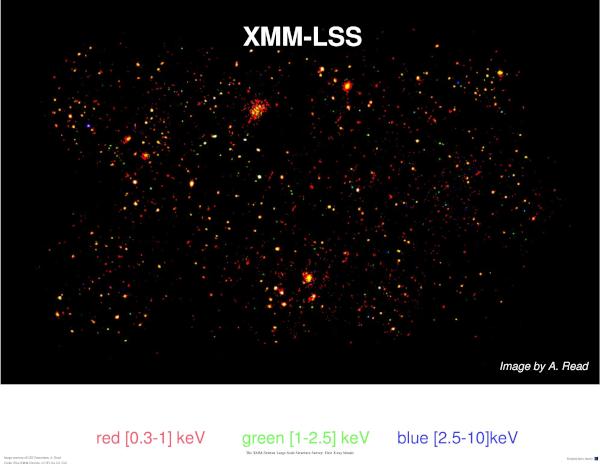The XMM-Newton Large Scale Structure Survey: First X-ray Mosaic

Minimum credit line: Image courtesy of LSS Consortium, A. Read and ESA. (for details, see Conditions of Use).
Credit: ESA/XMM-Newton, CC BY-SA 3.0 IGO
The image above can be displayed at full size and may be downloaded by clicking the image above.
| About this Image |
|---|
The XMM-LSS consortium has designed a medium deep large area X-ray survey with XMM-Newton - the XMM Large Scale Structure survey, XMM-LSS - with the scope of extending the cosmological tests attempted using ROSAT cluster samples to two redshift bins between 0 < z < 1 while maintaining the precision of earlier studies. Two main goals have constrained the survey design: the evolutionary study of the cluster-cluster correlation function and of the cluster number density. The adopted XMM-Newton observing configuration consists of an equatorial mosaic of 10 ks pointings, separated by 20 arcmin and covering 8 times 8 degr, giving a sensitivity of ~3 10-15 erg/s/cm2 in the [0.5-2] keV band. This will yield more than 800 clusters of galaxies and a sample of X-ray AGN with a space density of about 250 deg-2. Expected cosmological implications of the survey are in the general context of LambdaCDM models and cluster evolution. The XMM-LSS survey is associated to several other major surveys, ranging from the UV to the radio wavebands which will provide the necessary resources for X-ray source identification and further statistical studies. In particular, the associated CFHTLS weak lensing and AMiBA Sunyaev-Zel'dovich surveys over the entire XMM-LSS area, will provide for the first time a coherent study of the mass distribution and of cluster physics in the universe on scales of a few hundreds of Mpc. The image shows the largest deep X-ray image of the sky obtained so far (~5 10-15 erg/s/cm2 in the [0.5-2] keV band). The size of the displayed region is 1.6 square degree and corresponds to one third of the data collected so far. A wealth of objects (pointlike and extended), structures and X-ray colours is conspicuous. The XMM-LSS consortium is led by the Service d'Astrophysique du CEA (France) and consists of institutes from the UK, Ireland, Denmark, The Netherlands, Belgium, France, Italy, Germany, Spain and Chile. First XMM-LSS Papers: 1) The XMM-LSS survey: I. Scientific motivations, design and first results (linked below); 2) The XMM-LSS survey: II. First high redshift galaxy clusters: relaxed and collapsing systems, astro-ph/0305192
Investigator(s): LSS Consortium (PI: M. Pierre, CEA Saclay, France)
| For More Information |
|---|
- Read the Press Release
- Read the Journal article
- Visit related website;
http://vela.astro.ulg.ac.be/themes/spatial/xmm/LSS/index_e.html - Detailed description of this image
- Query XSA archive for XMM-Newton data in the field of Large Scale Structure Survey
- For unfamiliar terms, visit the XMM-Newton Astronomical Glossary
| Alternate Resolutions | (Help) |
|---|
This image is available in the following downloadable versions: Higher resolution versions of this image may be available, please contact the XMM-Newton HelpDesk.
Search the Image Gallery
To search the Image Gallery for a particular object, fill in the object name in the box below and click the Submit button.To search the Image Gallery for other images, fill in any of the fields below and click the Submit button.
For more search options, please use our Advanced Search form.